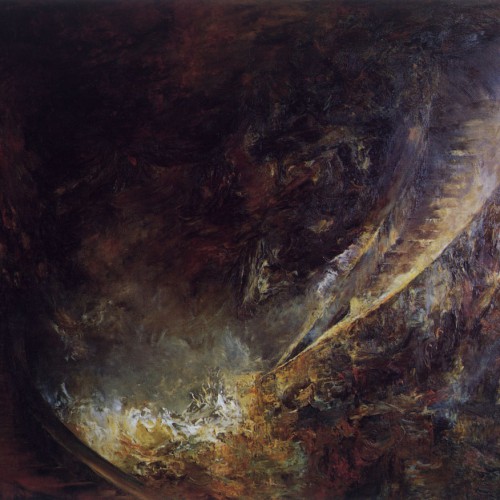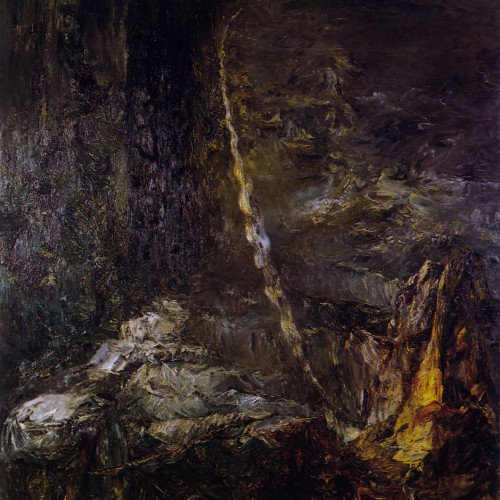Catherine Lampert’s essay, first published in the exhibition catalogue for Fool’s Gold, Gimpel Fils, London 1984.
- Quicksilver, 1984
- Mortal Coil, 1984
The mesmerising, restless atmosphere in Thérèse Oulton’s painting seems to stem from her expectation that art should provide a platform for self-mastery. The thread which binds her bold technique to the strange content, and which leads to successive paintings, is something spun from the specific curiosities and vulnerability of this painter. In her case painting involves pulling knowledge from the weight of civilization – facts about the physical and cosmic world, the art and music of the past, Catholicism and disbelief, and so on, through a web of strands and amorphous touches made from unashamedly spontaneous gestures. The success and promise of her art depends not only on high ambition, but also on her lack of circumlocution. It is as if on the one hand she is painting a cloak or blanket with confessional and protective purposes and on the other able to generalise and resolve. From a hint of the visionary the viewer rekindles and refreshes his own sense of destiny.
Oulton’s technique is not one which many artists feel comfortable using. She prepares a coloured ground and on a palette-table sets out pools of turpentine-thinned oil paint. With a sable brush, or sometimes her hands, she pushes wet paint into wet paint, perhaps working and completing the whole area in one session. When this is possible the painted surface is only one-skin deep. Nevertheless the variegated forms seem to have been caressed and battered into shape. Across the surface the flux, tempo and climaxes remind us of the coded messages an orchestra conductor sends: Oulton’s musical sense of continuum lends credibility and beauty to the most melodramatic eruptions.
Many of Oulton’s characteristic forms refer to the tradition of landscape painting as does her dominant use of greens, blues and browns. Yet she is not a landscape painter of earthly motifs. The precarious state of the paint when it is applied, inch by inch, is especially antagonistic to the kind of drawing which captures the character of a given natural model. While still fresh the traceries within a passage will be simply smeared back into the ground if they do not succeed in carrying the right message or movement This method is as risky and ungainly as it sounds. Marks spread mysteriously across the canvas without the guidance of a preliminary sketch or a sighting, yet the kinetic activity on the surface encourages the artist to treat the upright canvas as a protagonist. When Oulton catches the painted spectacle unawares, it reciprocates the dialogue, and she renews her attack. The granular spectrum of the entangled strokes preserves the consequence of one action on another: the dissolution of parts parallels the transmutation of her thoughts and feelings. Nothing is simply functional. The fast drying property of the thin medium does not present a handicap but rather instills euphoria and connects the ‘useless’ activity of painting to natural phenomena. Thus it is meaningful to the artist, that crudely speaking, the ground powder of the pigments (minerals) are bound in their liquid medium (molten rock) and under pressure rapidly achieve form in their dried state (like the surface of the earth).
All of Oulton’s paintings can be considered to some degree metaphorical, not least because of the alternative readings surrounding the titles. Details of the relationship between acquired knowledge and its autobiographical and pictorial significance are difficult for the viewer to decipher. Instead of extracting a ‘reading’ we find ourselves suspending scepticism and permitting the labyrinth of her furtive marks to embrace a form of truth. Many starting points, such as the watery tumulets spreading out from the bottom corners, the shivering enmeshed foliage, the vertical stalactites and the arched projectiles, give us the sense of space found in dreams and also their sexual connotations. Thus we float over the ocean and are engulfed in thick subterranean undergrowth. Several paintings use ageless symbolism, like the phallic column in her Fountain and the negative throne and linga in Rue. She enters uncharted areas when her hands leave impressions which, clarified by the illusionary perspective of a short distance, are intoxicatingly tactile. A number seem exclusive to her sex. The delicate filagree trails, the satiny peaks, the furry smears and the graceful outline of the harp, individually, express the way her gender fantasies, and remembers, being touched and touching.
In another artist’s hands the passages of spotlit tracery might become cloying. But here they don’t. There is always the danger of small areas remaining inarticulate and surfaces drying lifelessly. One of Oulton’s strengths is that she shows herself aware of not painting in a vacuum. Where there is the pursuit of extravagance, as with the shrill gold filagree or the grandiose staircases lost in heavenly space, there is also the irony of the masquerading penchant which is behind Western painting. Special references are made to the penumbra of the chiaroscuro approach, the escapism of the French 18th century and the juicy deceptions of post-Manet impasto.
When Therese Oulton’s work came to the public’s attention, at her Royal College of Art Diploma show in 1983, the large pictures like Rite carried the ambience of a secret garden. The way in which the contents seemed both private and dramatic suggested the apparitional desires of Turner and the wooded retreats of Watteau, Fragonard and Gainsborough. Despite her use of scrolled walls and dark hideaways Oulton’s temperament was never detached from the twentieth century by notions of a Romantic revival. She addressed, for example, the specific problem of running two colours into each other on a flat surface, looking to sustain a continuous field of both opaline and opaque patches. The references to late Monet which were in the air (and in the art of her tutors) following the exposure of his Giverny paintings were clearly engaging.
Formal issues continue to be indivisible from subject, and despite the difficulty of keeping syntax, Oulton persists in situating architectural fragments in even her smallest sketches. This happened last autumn after her visit to Italy when she began locating cypress trees and classical colonnades in Claudian middle-distances. It was not the references that were antithetical to her art, indeed the recurrent mood of Rococo expressionism lent an appealing lightheartedness. It was simply that the marriage of these particular forms and Oulton’s intended content was troublesome. The following series, the ‘Passions’ brought a spiral staircase within the context of a pulsating n1che of glowing marks, the entire structure supporting the ascending and descending dualism, meaning pinned by a central vortex.
A similar wholeness has been established in the dark ‘sous-bois’ studies like Midas’ Vein and the previous ‘To the Quick‘ group. Building from a terrestrial fundament upwards and outwards through the casement of undergrowth, light (enlightenment) is allowed to pierce the space and model the dominant image. The string of the bow in the large ‘To the Quick‘ painting becomes a liquid jet. The mast bends in the recent group of green paintings, indeed Mortal Coil and The Heart of the Matter use arches of opposing directions, one concave and one convex. The poignant rendering of the bull’s horns in The Heart of the Matter combines an aggressive nobility with the encumbered degeneration of clinging vegetation. The composition manages to coalesce without the journey from darkness to light, from black through the colour spectrum to white, which vitalises previous works like Galena. An equal emotional range is now achieved within the nuances of a close tonal band, like the direct embrace and the contradictions within a single octave. Copper Glance is a lovely, impressive example of Oulton’s hand spinning through painterly intervals, the right angles of the terrace disappearing into billowy clouds. As ‘copper’ contains the full metallic rainbow, ‘glance’ connotes both lustrous sulfide and intimations of a sudden apprehension of visual truth.
There are times when Oulton’s compositions deliberately invite stress. Cinnabar is an intriguing exposition of irreconcilables. Beyond a minefield of intensely individualised hillocks, a red cloth appears on the ridge, a flash of the mineral cinnabar which is the source for Venetian red. Its luxury perhaps implies the seductive legacy of Titian, Rubens and Velazquez. The harp above melts into a field of irridescent green whereas on the right a golden space dazzles the eye. But this area is actually a cluster of fervent brushstrokes that confront modern taste. Their odd facture is not an affectation but rather a testimony to her faith in the involuntary, like an African carver’s fidelity to the wood grain when he is fashioning a spirit. Cinnabar reminds us that Oulton’s mind seems empathetic to relative states of being, to the scientifically rational and to the occult and the homeopathic. Thus her fascination with gemstones extends to an awareness of the minerals carried in the body and in the pigments. Painting is called upon to purge the unwanted, like a tourniquet removing poisons, as well as to conjure and name its own kingdom.
Periodically Oulton finds herself dissatisfied with an ‘ego-centred’ format. Laying out the latest work Cardinal on the diagonal was a way of preventing the eye settling on a hierarchy of parts. Named for the obscure meaning of the word as ‘turning point’ as well as for the robes of Pope Innocent X, the painting introduces a pure red, a colour which previously had seemed unmanageable. The extremely seductive folds of the saturated portrait-feeling scarlet triangle are broken by an icey river and thrown into tumult in the upper right by the figural winds that send the eye restlessly back across the divide. This tension suggests that Oulton’s personal attraction to the bitterness of dichotomy is like her questioning of a masculine standard of successful painting. She seems to respect perseverance and prowess but be repelled by authoritarianism and analytic reductiveness. Preserving the intimacy and candour of female behaviour in its raw emotional state is a method of protecting the artist from painting with another person’s values.
Catherine Lampert

